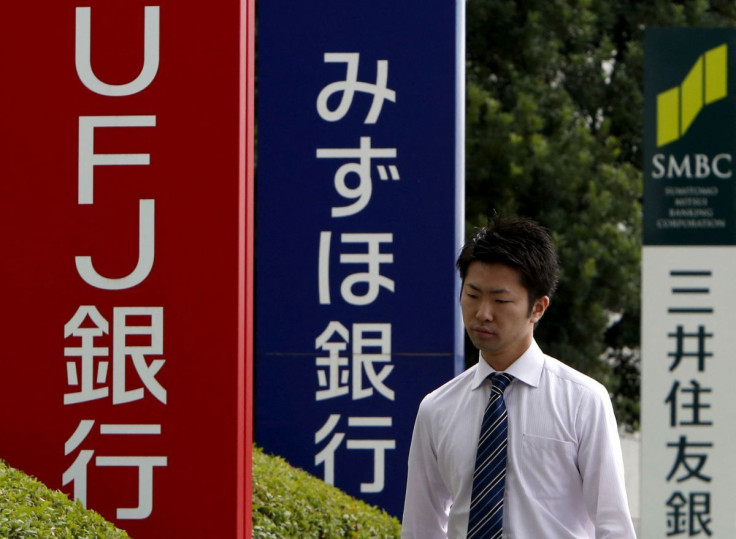Japan Banks Target Growth In Cooling U.S. High-yield Debt Market

When Japan's biggest banks helped finance a $34 billion deal last year for medical supply maker Medline, one of the largest leveraged buyouts since the financial crisis, the famously cautious lenders signalled their ambitions in riskier, and more lucrative, low-grade U.S. debt.
Mitsubishi UFJ Financial Group Inc, Mizuho Financial Group Inc and Sumitomo Mitsui Financial Group Inc, eagerly hunting yield abroad after years of zero rates at home, have beefed up U.S. operations and are now targeting business there lending to lower-rated borrowers and underwriting junk bonds.
But their timing - when interest rates are rising and the high-yield debt market is slowing - means they will face increasing risks and dwindling opportunities, testing their staying power.
"We'll need to closely monitor the course of the markets following the latest contraction," said Shinichi Sato, an executive officer at Mitsubishi UFJ, Japan's biggest lender.
He was nevertheless positive about the prospects: "The market for non-investment grade financing will likely remain on a growth trend."
The big Japanese banks still have a long way to go to become major players in the market.
Mitsubishi UFJ, which has a tie-up with Morgan Stanley, had a 1.6% share of the estimated $18 billion fees in the non-investment grade debt market last year, according to Dealogic, the most of any Japanese bank.
It aims to move up five spots in the league table for non-investment grade bonds and loan syndication in the next two years, to 12th place.
LOCAL KNOWLEDGE
Because non-investment grade borrowers are seen as more likely to default, deals require closer attention to local conditions, bankers say.
Developing that expertise has been a challenge for Japanese banks, requiring more reliance on local staff and adoption of a faster-moving business culture, they say.
Mizuho has expanded its presence in the United States following its 2015 acquisition of Royal Bank of Scotland's North American corporate loan portfolio, where it also brought on board some 150 former RBS bankers.
"U.S. banks and investment banks are cutting edge in terms of their business models and governance, and we have developed our presence with talented bankers joining Mizuho," said Yusuke Kasamatsu, a senior Mizuho banker.
"We took on board their perspective and raised our game."
It bolstered ties with investment-grade clients and then reached out to lower-rated borrowers as it deepened its knowledge, Kasamatsu said.
Rivals took notice when Mizuho's profits from the U.S. business surged in 2020, said a senior executive at another megabank.
"The RBS deal changed their culture," the executive said, declining to be identified because of the sensitivity of the topic. "They sped up the due diligence process and beefed up risk control. The former RBS bankers told them what needed to be changed and they listened."
Its U.S. securities business more than doubled earnings to 60 billion yen ($467 million) in the year through March 2021, after trebling a year earlier.
Its share of the high-yield fee pool is 1.5% and has doubled in three years, according to Dealogic.
Sumitomo Mitsui last year took a 5% stake in Jefferies Financial Group Inc, in part to target high-yield deals.
"As our U.S. capabilities were weak, we couldn't benefit fully from the buoyant capital markets" that helped boost Mizuho, Sumitomo Mitsui CEO Jun Ohta said in a December interview.
NEW RISKS
But the expansion in the United States, and especially in the high-yield debt market, will pose new risks for the big lenders.
The Bank of Japan has taken notice, saying exposure to high-risk assets, while small, could saddle lenders with unexpected losses.
As the banks pursue greater fee revenues, they need to "assess the quality and risks of their portfolios", the central bank said recently.
While Japanese financial institutions generally hedge against the risk of default by selling on the loans in the secondary market, they have been stung on Wall Street before.
In last year's collapse of hedge fund Archegos Capital, Nomura Holdings took a $2.9 billion hit. During the subprime crisis, Mizuho was the worst hit of the Japanese banks, losing some $6 billion.
At the regulatory Financial Services Agency, an official said it was "reasonable" for the banks to enter the high-yield market overseas after gaining investment-grade debt experience.
"It's also important to strengthen the risk control framework in line with their strategies, and we're closely watching it," said the official, who declined to be identified by name.
The banks need to know how much risk they can withstand in times of market distress, said Rie Nishihara of JPMorgan Securities in Japan.
In such cases, there is a difference in speed between top- and second-tier banks in accessing information, she said, pointing to the Archegos collapse, where top-tier investment banks emerged relatively unscathed.
($1 = 128.3900 yen)
© Copyright Thomson Reuters 2024. All rights reserved.


















